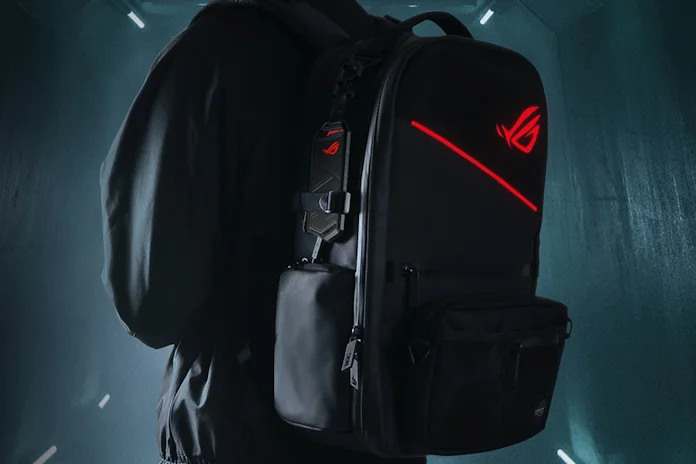If you’re like many PC users, you have a small but growing stash of M.2 drives somewhere in your house. For years now, these gumstick-sized storage drives have been the de facto standard for PCs thanks to their easy installation and tiny size — not to mention the fact that their transfer speeds absolutely crush what you can get from traditional hard drives. You might even have one or more languishing in a laptop that you no longer use. If you’re wondering whether it’s possible to get more value out of one of these drives, the answer is yes. Pop it into a portable SSD enclosure, and you’ll have a durable, high-performance external storage device that you can take anywhere.
Of course, you aren’t limited to the M.2 drives living in the back of an office desk drawer when you’re setting up a portable SSD enclosure. High-performance, high-capacity M.2 drives are readily available today for surprisingly low prices. With the right portable SSD enclosure, you can quickly and affordably assemble a convenient, speedy external storage device.
What is a portable SSD enclosure?
Simply put, a portable SSD enclosure is a small device that has two primary jobs. First, it connects an SSD to another device, typically a laptop or desktop PC, though game consoles, gaming handhelds, smartphones, and tablets are other possibilities. Second, it encloses and protects the SSD so that you can safely take it with you.
People use portable SSD enclosures in many ways. This versatile storage option is invaluable for transferring large quantities of data, like raw video files or game installation files, from one device to another. It makes it easy to back up important files or photos from a variety of devices, all without waiting on potentially slow upload speeds to the cloud. And it gives you a convenient way to back up your PC’s files to a separate, local device.
What makes a good portable SSD enclosure?
Not all portable SSD enclosures are the same. As you’re comparing your options, keep the following factors in mind.
Ease of installation
The best portable SSD enclosures give you a fast and hassle-free installation process. The screws used to hold M.2 drives are very small and easy to lose, so you very well might prefer a model that allows for tool-free installation.
Max transfer speeds
Portable SSD enclosures offer different max transfer speeds depending on the model, and the read and write speeds offered by M.2 SSDs varies as well. If you’re planning to install a high-performance PCIe 5.0 SSD into a portable SSD enclosure, you might be best off with a high-speed enclosure. If you’re using an older-gen M.2 SSD, you’re unlikely to be bottlenecked by the transfer speed of the portable SSD enclosure. Please note that max transfer speeds are also limited by the device that you’re connecting the portable SSD to, as not all USB ports offer the same bandwidth.
Effortless cooling
M.2 drives require some measure of cooling for stable operation. Faster drives produce more heat, so if you’re going to use a PCIe 4.0 or PCIe 5.0 M.2 SSD, make sure that your portable SSD enclosure offers sufficient cooling.
Protection against wear and tear
When an M.2 drive is installed in your laptop or desktop, it’s protected by the chassis of your PC. When you repurpose the drive as an external storage device, you need its new enclosure to take on the protection duties. Look for sufficient protection against dust and water, and protection against fall damage might be worth considering, as well.
M.2 drive size compatibility
M.2 SSDs come in a variety of lengths. M.2 2280 drives are most common, but longer M.2 22110 drives are getting more popular thanks to their potentially higher capacity, and there are smaller sizes on the market, too. Make sure that your portable SSD enclosure can fit the drive that you have on hand.
Interface compatibility
M.2 drives typically use one of two interfaces. PCIe drives are the standard these days, but a few years ago SATA was quite common, as well. Most portable SSD enclosures these days are compatible with PCIe M.2 SSDs, but if you’re repurposing a drive from several years ago, you might need a portable SSD enclosure that’s also compatible with SATA drives.
Operating system compatibility
It’s worth your time to check and make sure that your portable SSD enclosure is compatible with the devices that you want to connect it to.
Style
A portable SSD enclosure is so convenient and helpful that you might end up taking it with you to more places than you initially expect. You might be happiest in the long run with a portable SSD enclosure with style the coordinates with the rest of your gear.
How do I install an SSD in a portable SSD enclosure?
Check the installation instructions for your specific model, but you can expect an easy, quick process when it comes to installing an M.2 drive into a portable SSD enclosure. This video shows how fast it can be.
Briefly put, you’ll open the portable SSD enclosure. Inside, you’ll find a small slot. Line up the M.2 drive with the contacts in this slot (a notch on the end of the drive will guide you), hold the drive at a 45° angle, and insert it into the slot. Gently push the other end of the drive down into the enclosure and secure it in place. The best portable SSD enclosures will have an easy mechanism for securing the end of the drive, but some might require you to hold the end in place with a small, included screw. Some enclosures might have a follow-up step where you apply a thermal pad. Once the drive and any cooling solution are in place, close up the portable SSD enclosure and you’re ready to connect it to your device via a USB cable.
What USB port should I connect a portable SSD enclosure to?
Not all USB ports offer the same max transfer speeds. For the best experience, you’ll want to connect your portable SSD enclosure to the fastest USB port available.
On a modern desktop or laptop, that’d be a USB Type-C port. A variety ports use this same form factor, including Thunderbolt 4 ports, USB4 ports, and USB 20Gbps ports, and they’re all more than ready for the fastest portable SSD enclosures. USB Type-C ports with 10Gbps max transfer speeds are a little slower but also quite common. If that’s the max speed of your portable SSD enclosure, these ports will serve you well.
How about USB Type-A ports? For the most part, they won’t keep up with your portable SSD enclosure, though they can work in a pinch. There are USB 10Gbps Type-A ports that can keep up with USB 10Gbps (sometimes called USB 3.2 Gen 2×1) portable SSD enclosure. Often, but not always, these ports are red for easy identification.
What’s this about “max” transfer speeds?
When it comes to the actual speed of your portable SSD enclosure, there are a wide range of variables. The USB interface is just one part of the picture.
USB cables are capable of different transfer speeds (that’s why it’s best to use the one that came in the box with your enclosure). The different USB ports you connect your portable SSD enclosure to have their own max transfer speeds, which might be lower than what your enclosure can offer. M.2 drives themselves vary when it comes to performance, and their actual speed at any given moment depends on the specific operation that you’re using. Write speeds and read speeds are rarely the same, and that’s just scratching the surface of the subject.
It’s also worth noting that transfer speeds are measured in different ways depending on the context. When you move a file from one drive to another in Windows, the operating system tells you the transfer speed in megabytes per second (MB/s), but the max transfer rates of USB ports are typically measured in gigabits per second (Gbps). A portable SSD enclosure featuring 10Gbps max transfer speeds, for example, will be capable of 1250 MB/s transfers theoretically, and a bit closer to 1000 MB/s in action.
As you’re selecting a portable SSD enclosure and picking between different max transfer speeds, mostly what you’re trying to do is make sure that your enclosure isn’t the limiting factor. For most folks in most scenarios, a 10Gbps portable SSD enclosure does just that. Grab a 20Gbps alternative if you know that you can take advantage of the extra speed or if you’re looking for an extra measure of future-proofing.
How do portable SSD enclosures compare to flash drives?
When people go looking for portable external storage options, they often end up considering flash drives. These thumb-sized drives are small, readily available, and convenient. Increasingly, you can find options that offer high transfer speeds and spacious storage, too.
While portable SSD enclosures aren’t that large, a flash drive might be your best bet for scenarios where you need a very tiny solution. But for people looking to repurpose an M.2 SSD that they already own, and for people who prioritize fast performance, portable SSD enclosures are the better pick. Also, there’s the question of repairability. If your flash drive fails, you’ll end up tossing the whole thing and getting a replacement. If the M.2 SSD in your portable SSD enclosure fails, you can swap out the SSD and continue to make use of the enclosure.
The best portable SSD enclosure for most users: the ASUS Cobble
If you’re looking for a quick recommendation for a portable SSD enclosure, here’s your pick: the ASUS Cobble. It offers a sleek design, robust protection, effortless performance, and comprehensive cooling for a very accessible price.
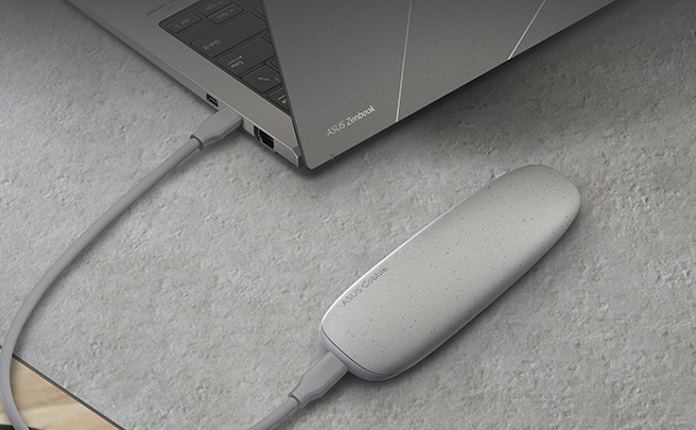
Everyone has their opinions when it comes to style, but it’s hard to imagine a scenario where the Cobble will feel out of place. With its nature-inspired rounded curves reminiscent of a cobblestone, it fits seamlessly with modern laptop design, especially models from the ASUS Zenbook lineup.
When it comes to performance, the Cobble will more than meet the needs of most users. Its USB 10Gbps connection serves up max transfer speeds that dwarf what you’ll get from external storage solutions based on HDDs. It offers a dual M.2 interface, allowing you to install either SATA or PCIe SSDs. An internal thermal pad and its aluminum-alloy top cover ensure efficient heat dissipation so that the Cobble can maintain consistent data performance even during lengthy transfers.
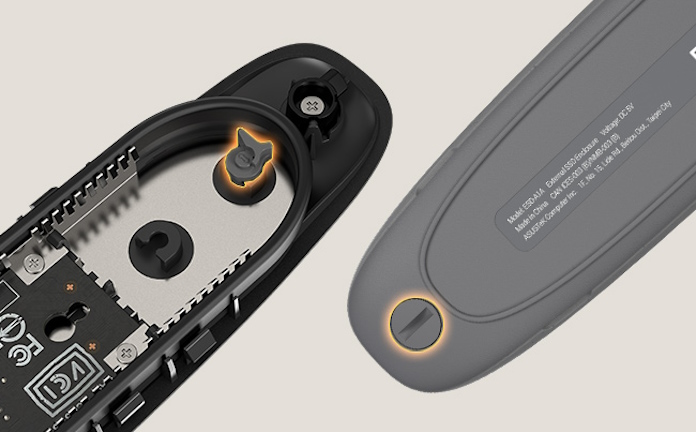
Installation is a breeze, too. The Cobble uses the innovative ASUS M.2 Q-Latch mechanism to secure your drive, allowing you to install or replace an SSD without the need for tools or screws.
On top of all that, the Cobble is equipped to shrug off the wear and tear of everyday use. It’s IP55-rated, offering reasonable protection against dust and spills, and its scratch-resistant finish ensures that it’ll keep its good looks for the long term.
| ASUS Cobble | |
|---|---|
| US | ASUS Amazon |
The best portable SSD enclosure for enthusiasts and frequent travelers: the TUF Gaming A2
Perhaps you’re looking for even faster transfer speeds and even more peace of mind that your portable SSD enclosure can withstand bumps, spills, and accidental drops. Consider the TUF Gaming A2. It kicks the transfer speeds up to 20Gbps, giving it the bandwidth to let a premium M.2 SSD stretch its legs and run.
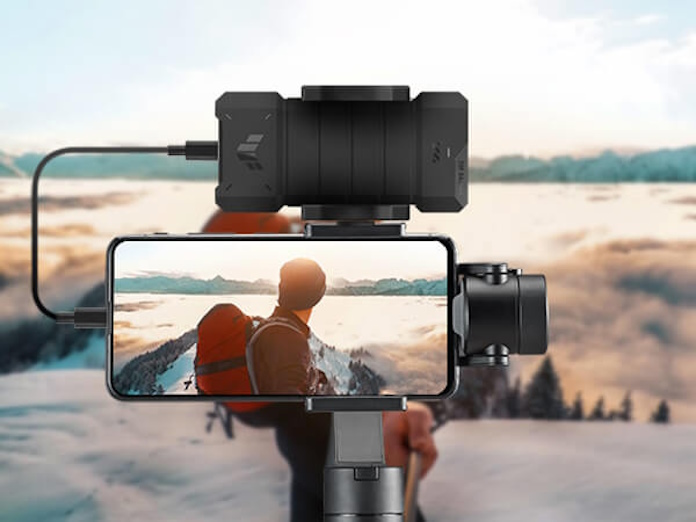
This portable SSD enclosure is equipped for the rigors of everyday operation with a robust silicone rubber exterior that gives it unmatched durability. It meets MIL-STD-810H standards for drop resistance, and it offers IP68-rated water and dust resistance, as well. As with the Cobble, it gives you tool-free drive installation, broad compatibility across most popular operating systems, and a highly effective thermal solution.
| TUF Gaming A2 | |
|---|---|
| US | ASUS Amazon Micro Center |
If you like the style and features of the TUF Gaming A2, but don’t intend to make use of its 20Gbps transfer speeds, consider the TUF Gaming A1. Offering a broadly similar feature set aside from its USB 10Gbps interface, it’s a reasonable choice for folks who won’t be installing a bleeding-edge SSD, and it’s a few bucks cheaper, too.
| TUF Gaming A1 | |
|---|---|
| US | ASUS Amazon B&H |
| CA | Newegg Amazon Canada Computers |
The best portable SSD enclosure for anyone who prefers not to install a drive: the TUF Gaming AS1000, AS1000 PLUS, or AS2000 PLUS
Some folks love the do-it-yourself approach for external storage. But perhaps you’d prefer to pull a complete, ready-to-go portable SSD enclosure out of a box, no M.2 installation required. That’s no problem at all. We have several TUF Gaming portable SSD enclosures available with pre-installed M.2 drives.
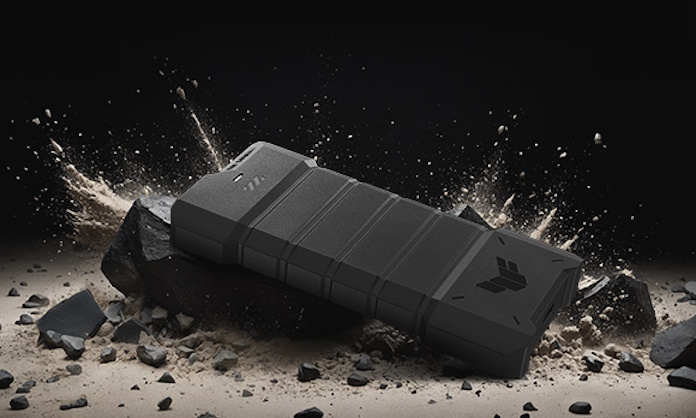
The TUF Gaming AS1000 is essentially a TUF Gaming A1, but with a preinstalled 1TB PCIe SSD. Want the faster max transfer speeds? Grab the TUF Gaming AS1000 PLUS, which ups the ante with its USB 20Gbps interface. Want both faster max transfer speeds and a larger drive? Go for the TUF Gaming AS2000 PLUS, which boasts a 2TB M.2 SSD and 20Gbps max transfer speeds.
| TUF Gaming AS Series | |||
|---|---|---|---|
| Model | Capacity | Max. Speed | US |
| TUF Gaming AS1000 | 1TB | 10Gbps | ASUS Micro Center |
| TUF Gaming AS1000 PLUS | 1TB | 20Gbps | ASUS Amazon |
| TUF Gaming AS2000 PLUS | 2TB | 20Gbps | ASUS Amazon |
The best portable SSD enclosure for gamers: the ROG Strix Arion
Thus far, we’ve looked at portable SSD enclosures with understated style. If you’re looking for an option that’s not just practical but fun, check out the ROG Strix Arion.
Boasting speedy 10Gbps transfer speeds, support for fast PCIe M.2 SSDs, tool-free installation, and excellent cooling thanks to an aluminum alloy case and dedicated thermal pads, the ROG Strix Arion checks all your boxes for lightning-quick external storage. But it adds some classic gamer style to the mix with ambient RGB LED lighting effects that are endlessly customizable through ASUS Aura Sync. Connect it to your ROG gaming setup, and you’ll have a coordinated lightshow that’s underscored by the angular lines crossing the surface of the Arion. You’ll even be able to keep this stylish portable SSD enclosure while you’re on the move thanks to its bundled hanging protective holder with a detachable R-hook.
| ROG Strix Arion | ||
|---|---|---|
| Black | US | Amazon |
| CA | Newegg Amazon Best Buy |
|
| White | US | ASUS |
| CA | Newegg Amazon Best Buy |
|

